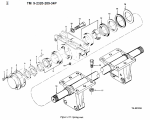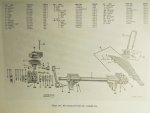rustystud
Well-known member
- 9,402
- 3,392
- 113
- Location
- Woodinville, Washington
OK, I agree that my "pressure greaser" was more then likely the culprit here. But it can happen. Also my system did not have that felt washer you mentioned. Maybe it was decided by the military to delete it, or the last soldier putting it back together forgot it. Who knows. The whole point of this was it can happen and you must admit your message to me was totally different in how you've addressed others in the past who you thought where in the wrong. You usually say something like "well in my opinion that cannot happen due to this or that" not "think before you post" . That implies the person is stupid or something worse. Of course Doghead will give me another infraction for bringing this up. He basically told me to play nice or leave like I said I would. ( Of course I never said I was going to leave just never post any of my modifications like my "power steering project" and "transmission project" and on and on). I thought I've been pretty reasonable considering I was basically being called stupid. We will see what happens. At this point I don't care. After my heart attack I've realized there are many other things more important to me then posting here.OK, what if we added this phrase:...."but if you pump in grease normally (by using a REGULAR HAND PUMP) you will get grease coming out the back, without damaging any seals"...
Think about this, Rusty: how else would the operator be able to "flush" any old grease out of the inner bearing?
Just for fun, I did some (greasing) "tests", today... (I got curious and wanted to see how hard (or easy) it was to actually "blow out" one of those rubber seals/ shields...)
The parts shown in the following pictures all felt very tight, with no play at all. And all of them had the newer, rubber type shield...
Of course, I did not loosen the cap, on purpose and just pumped grease in, from the bottom.
1st one took a while (to compress the obvious air pockets), but what finally came out at the back side was some dark stuff with the consistency of chewing gum (!) Talk about old grease...! I could actually feel the resistance in the pump, but the thing is, that gum did squeeze out, without doing anything to the shield and washers.
I stopped when it started leaking (fresh grease) at the front. So maybe I blew the cap gasket, but not the rear seal.
View attachment 748318 View attachment 748319
2nd one, after about 20 pump strokes, just clean grease (no old stuff) started coming out the back, with very little resistance. After wiping it off, the seal looked as good as before. So, again, no sucess... (in popping the seal)
View attachment 748320
Of course, isolated test results don't prove anything. And I do acknowledge that things can go wrong, eventually. One single case is proof enough.
Every case may be a bit different. Brand new parts - which most of us don't have - might be a tighter fit, shield to housing?
(as always: "your mileage may vary...")
Again, my humble opinion - after years of working on these things: the whole design is far from ideal, and there is very little we can do to improve it.
One thing I always did was to move that grease zerk out of harms way and place it where everyone can see it - easy to reach and inviting" at least... People in my country don't read TMs, not in English, not in Spanish. But even a moron knows what a grease zerk is for, so there is a slight chance at least that they do add some fresh grease, from time to time!
It has yet to happen that one of those seals popped out, almost like exploded, as seen in Rusty's picture..
Rant over.
Now about the zerk fitting. I agree with you Gerhard. I personally like have the zerk on the hub. Much easier then crawling under the truck to grease. Maybe it will not allow the grease to go everywhere, but it will inject enough good grease to keep things from seizing up. That is the main thing anyway. Also this is a bad design. It would have been far better to have roller bearings (like it used to have but larger) and a oil bath system. With a good modern seal there is no way water would ever get in, and the oil would keep those bearings going for thousands of miles. Just look at the modern trucks with front oil hubs.
So my final thoughts on this subject is grease the zerks carefully. You never know what can happen. Also the relief valve works fine in my system.
















